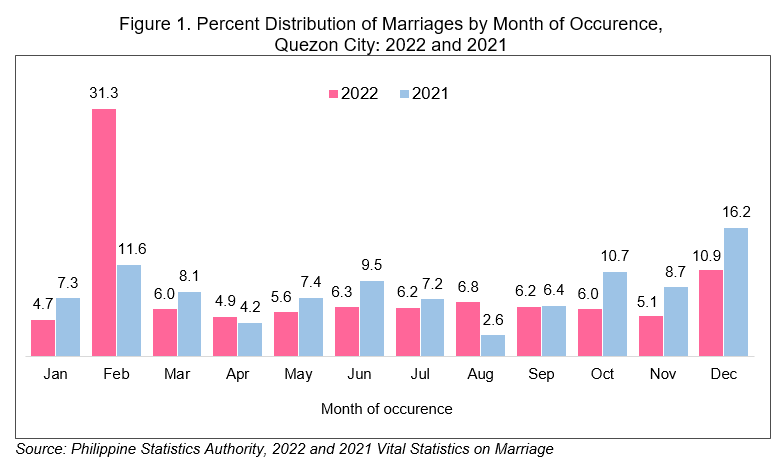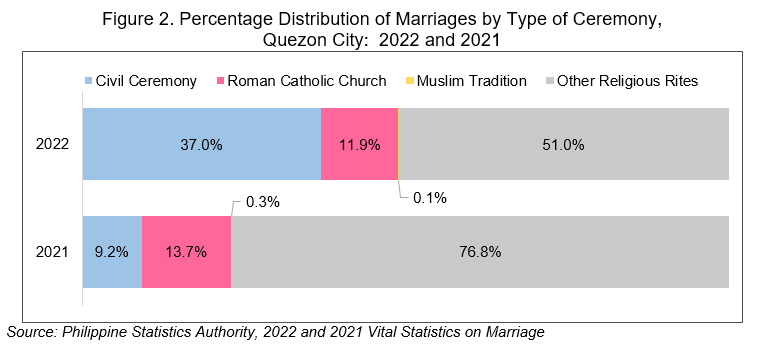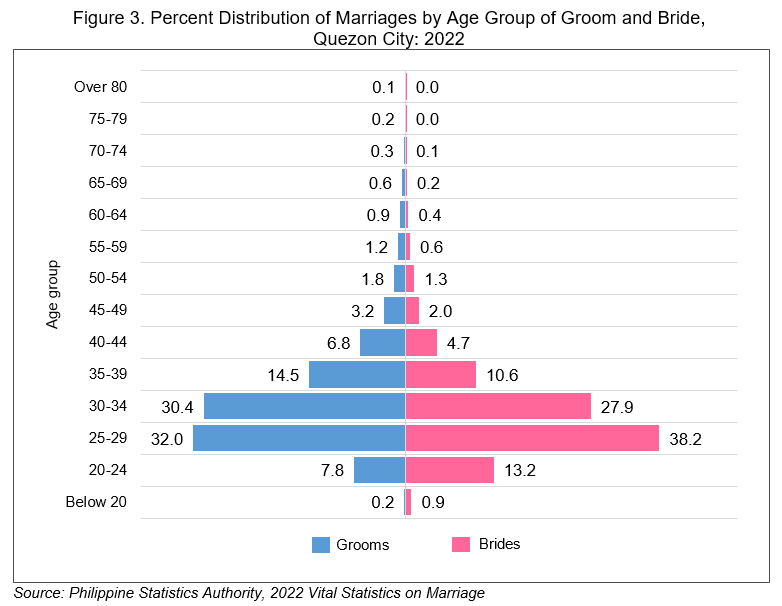Explanatory Note
Data on marriages in this release were obtained from timely and belatedly registered marriages at the Local Civil Registry Office of Quezon City, which was subsequently forwarded to the Philippine Statistics Authority-National Capital Region Provincial Statistical Office II (PSA-NCR PSO II).
The data presented includes marriages registered from January to December 2022, based on data files received by the PSA–Civil Registration Service from the PSA-NCR PSO II.
Registered marriages in Quezon City increase by 40.3 percent
There were 18,518 marriages registered in Quezon City for the year 2022, recording an increase of 40.3 percent from 13,200 figure of the previous year.

Out of the total marriages, 13,244, or 71.5 percent, were registered timely while 5,274, or 28.5 percent, were registered late. This data recorded a significant difference with the percentage of timely and late registered marriages for 2021 with 91.0 percent and 9.0 percent respectively.
February posted the highest number of marriages in 2022
The highest number of marriages in 2022 occurred in February at 5,789, or 31.3 percent, followed by December with 2,020, or 10.9 percent, and August with 1,260, or 6.8 percent of the total marriages. Meanwhile, April and January recorded the least number of marriages, with 916, or 4.9 percent, and 862, or 4.7 percent, respectively

Compared with 2021, the month of December recorded the highest number of marriages with 2,144, or 16.2 percent of the total marriages in the year.
One in two marriages are solemnized through other religious rites
More than 2,000 matrimonial ceremonies (11.9%) in Quezon City were officiated by Roman Catholic Church, 37.0 percent were civil weddings while 0.1 percent were conducted under Muslim Tradition. The remaining 51.0 percent were solemnized through Other Religious Rites.

Civil weddings increased fourfold in 2022, from 1,215, or 9.2 percent, in 2021 to 6,846, or 37.0 percent, in 2022. Among the four, it exhibits a remarkable increase.
Most men and women marry at the age of 25 to 29
The highest frequency of marriages in 2022 occurred among the age group 25 to 29, corresponding to 5,928 grooms (32.0%) and 7,075 brides (38.2%).
Additionally, there were 159, or 0.9 percent, of the registered brides and 38, or 0.2 percent, of the registered grooms who entered the wedding ceremony at the age of 19 years old and below. The youngest groom and bride recorded in the year were married at 18 years old.

On the average, women marry at the age of 29; men at 31
In Quezon City, the median age for grooms has increased to 31, a year older than the previous year, while the median age for brides remains unchanged at 29. This reflects a pattern of men marrying at slightly older ages, with no change observed for women.
One out of 20 marriages are transnational
Out of 18,518 marriages registered in Quezon City, 17,521 were found to be between both Filipinos. Among intermarriages with foreign nationals, a total of 912 Filipino women married non-Filipino men, while 77 Filipino men married women of foreign nationals. The other eight marriages involved foreign nationals.

HELEN L. ADOLACION
Chief Statistical Specialist
JCA/CD
TECHNICAL NOTES
Vital statistics are derived from information obtained at the time when the occurrences of vital events and their characteristics are inscribed in a civil register.
Vital acts and events are the births, deaths, fetal deaths, marriages, and all such events that have something to do with an individual's entrance and departure from life together with the changes in civil status that may occur to a person during his lifetime. Recording of these events in the civil register is known as vital or civil registration and the resulting documents are called vital records.
Marriage is a contract of permanent union between a man and a woman entered in accordance with law for the establishment of conjugal and family life. It is the foundation of the family and an inviolable social institution whose nature, consequences, and incidence are governed by law and not subject to stipulation, except that marriage settlements may fix the property relations during the marriage within the limits provided in the Family Code of the Philippines.
Daily Average refers to the arithmetic mean of marriage occurrences per day.
Sex Ratio refers to the number of males per one hundred females.
Usual Residence refers to the place where the person habitually or permanently resides.
Place of Occurrence refers to the place where the vital event took place.
